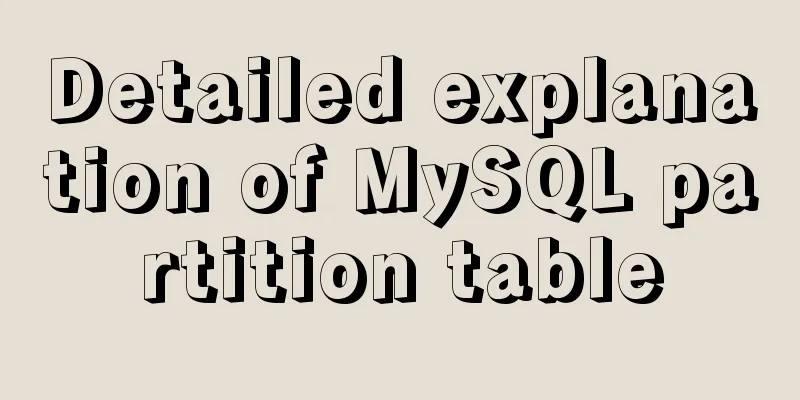Detailed explanation of MySQL partition table

|
Preface: Partitioning is a table design pattern. Generally speaking, table partitioning is to divide a large table into several small tables based on conditions. But for the application, the partitioned table is the same as the non-partitioned table. In other words, partitioning is transparent to the application and is just a reorganization of data by the database. This article introduces partition tables in MySQL and their usage scenarios. Friends in need can refer to it. I hope it will be helpful to you. 1. Purpose and type of partition When creating a table in MySQL, you can use the PARTITION BY clause to define the data stored in each partition. When executing a query, the optimizer filters out partitions that do not have the data we need based on the partition definition, so that the query does not need to scan all partitions, but only needs to find the partition that contains the required data. Another purpose of partitioning is to store data in different tables at a coarser granularity. Doing so can store related data together. In addition, it will be convenient when we want to delete the data of an entire partition in batches at one time. The following briefly introduces four common partition types:
Among the above four partition types, RANGE partitioning is the most commonly used. The characteristic of RANGE partitioning is that the ranges of multiple partitions must be continuous but cannot overlap. By default, the VALUES LESS THAN attribute is used, that is, each partition does not include the specified value. 2. Partition operation example This section takes RANGE partitioning as an example to introduce operations related to partition tables. # Create a partitioned tablemysql> CREATE TABLE `tr` ( -> `id` INT, -> `name` VARCHAR(50), -> `purchased` DATE -> ) ENGINE=InnoDB DEFAULT CHARSET=utf8 -> PARTITION BY RANGE( YEAR(purchased) ) ( -> PARTITION p0 VALUES LESS THAN (1990), -> PARTITION p1 VALUES LESS THAN (1995), -> PARTITION p2 VALUES LESS THAN (2000), -> PARTITION p3 VALUES LESS THAN (2005), -> PARTITION p4 VALUES LESS THAN (2010), -> PARTITION p5 VALUES LESS THAN (2015) -> ); Query OK, 0 rows affected (0.28 sec) # Insert datamysql> INSERT INTO `tr` VALUES -> (1, 'desk organiser', '2003-10-15'), -> (2, 'alarm clock', '1997-11-05'), -> (3, 'chair', '2009-03-10'), -> (4, 'bookcase', '1989-01-10'), -> (5, 'exercise bike', '2014-05-09'), -> (6, 'sofa', '1987-06-05'), -> (7, 'espresso maker', '2011-11-22'), -> (8, 'aquarium', '1992-08-04'), -> (9, 'study desk', '2006-09-16'), -> (10, 'lava lamp', '1998-12-25'); Query OK, 10 rows affected (0.03 sec) Records: 10 Duplicates: 0 Warnings: 0 After creation, you can see that each partition corresponds to an ibd file. The above creation statement is easy to understand. In this partition table, the year in the DATE date is extracted through the YEAR function and converted into an integer. Years less than 1990 are stored in partition p0, years less than 1995 are stored in partition p1, and so on. Note that each partition is defined in order from lowest to highest. In order to prevent the inserted data from reporting an error due to not finding the corresponding partition, we should create a new partition in time. The following will show other operations related to partition maintenance. # View the data of a partitionmysql> SELECT * FROM tr PARTITION (p2); +------+-------------+------------+ | id | name | purchased | +------+-------------+------------+ | 2 | alarm clock | 1997-11-05 | | 10 | lava lamp | 1998-12-25 | +------+-------------+------------+ 2 rows in set (0.00 sec) # Add partitionmysql> alter table tr add partition( -> PARTITION p6 VALUES LESS THAN (2020) -> ); Query OK, 0 rows affected (0.06 sec) Records: 0 Duplicates: 0 Warnings: 0 # Split partitionmysql> alter table tr reorganize partition p5 into( -> partition s0 values less than(2012), -> partition s1 values less than(2015) -> ); Query OK, 0 rows affected (0.26 sec) Records: 0 Duplicates: 0 Warnings: 0 # Merge partitionsmysql> alter table tr reorganize partition s0,s1 into ( -> partition p5 values less than (2015) -> ); Query OK, 0 rows affected (0.12 sec) Records: 0 Duplicates: 0 Warnings: 0 # Clear the data of a partition mysql> alter table tr truncate partition p0; Query OK, 0 rows affected (0.11 sec) # Delete partition mysql> alter table tr drop partition p1; Query OK, 0 rows affected (0.06 sec) Records: 0 Duplicates: 0 Warnings: 0 # Exchange partition # First create an exchange table with the same structure as the partition table mysql> CREATE TABLE `tr_archive` ( -> `id` INT, -> `name` VARCHAR(50), -> `purchased` DATE -> ) ENGINE=InnoDB DEFAULT CHARSET=utf8; Query OK, 0 rows affected (0.28 sec) # Execute exchange partition mysql> alter table tr exchange PARTITION p2 with table tr_archive; Query OK, 0 rows affected (0.13 sec) 3. Partition considerations and applicable scenarios In fact, there are many restrictions and precautions when using partition tables. Referring to the official documentation, a few points are briefly summarized as follows:
From the above introduction, we can see that partition tables are suitable for some logging tables. This type of table is characterized by a large amount of data, distinction between cold and hot data, and data archiving according to the time dimension. This type of table is more suitable for using partition tables, because partition tables can maintain separate partitions, which is more convenient for data archiving. 4. Why partition tables are not commonly used In our project development, partition tables are rarely used. Here are a few reasons:
Summarize: This article introduces MySQL partitioning in detail. If you want to use partitioned tables, it is recommended to plan ahead, create partitioned tables during initialization, and make maintenance plans. It is quite convenient if used properly, especially for tables that require historical data archiving. Using partitioned tables will make archiving more convenient. Of course, there is a lot more content about the partition table. Students who are interested can look for the official documentation, which contains a large number of examples. The above is a detailed explanation of MySQL partition table. For more information about MySQL partition table, please pay attention to other related articles on 123WORDPRESS.COM! You may also be interested in:
|
<<: Vue component communication method case summary
>>: Apache Bench stress testing tool implementation principle and usage analysis
Recommend
JavaScript recursion detailed
Table of contents 1. What is recursion? 2. Solve ...
WeChat applet custom scroll-view example code
Mini Program Custom Scroll-View Scroll Bar Withou...
Vue implements simple comment function
This article shares the specific code of Vue to i...
This article helps you understand PReact10.5.13 source code
Table of contents render.js part create-context.j...
How to create a simple column chart using Flex layout in css
The following is a bar chart using Flex layout: H...
CSS3 uses transform deformation combined with events to complete fan-shaped navigation
Because I wrote the word transition incorrectly i...
MySQL data operation-use of DML statements
illustrate DML (Data Manipulation Language) refer...
How to implement CSS mask full screen center alignment
The specific code is as follows: <style> #t...
How to achieve centered layout in CSS layout
1. Set the parent container to a table and the ch...
React Principles Explained
Table of contents 1. setState() Description 1.1 U...
How to use Vue3 mixin
Table of contents 1. How to use mixin? 2. Notes o...
Detailed explanation of linux crm deployment code
Linux basic configuration Compile and install pyt...
JSONP cross-domain simulation Baidu search
Table of contents 1. What is JSONP 2. JSONP cross...
Navicat multiple ways to modify MySQL database password
Method 1: Use the SET PASSWORD command First log ...
Hyper-V Introduction and Installation and Use (Detailed Illustrations)
Preface: As a giant in the IT industry, Microsoft...









